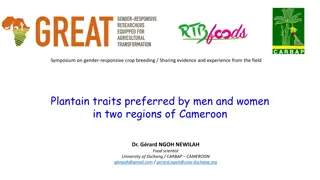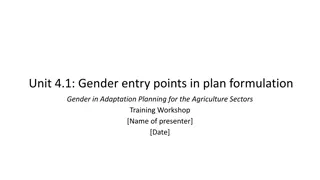Gender Differences in Tournament Choices: Risk Preferences, Overconfidence, or Competitiveness?
Study explores gender disparities in competitiveness within tournament settings, impacting labor market outcomes. Discusses women's likelihood to choose tournaments, linking to risk aversion and confidence levels. Key study by Niederle & Vesterlund (2007) highlights women's reduced willingness to compete despite comparable task performance, shedding light on the concept of competitiveness as a new personality trait.
Uploaded on Feb 15, 2025 | 0 Views
Download Presentation

Please find below an Image/Link to download the presentation.
The content on the website is provided AS IS for your information and personal use only. It may not be sold, licensed, or shared on other websites without obtaining consent from the author.If you encounter any issues during the download, it is possible that the publisher has removed the file from their server.
You are allowed to download the files provided on this website for personal or commercial use, subject to the condition that they are used lawfully. All files are the property of their respective owners.
The content on the website is provided AS IS for your information and personal use only. It may not be sold, licensed, or shared on other websites without obtaining consent from the author.
E N D
Presentation Transcript
Gender Differences in Tournament Choices: Risk Preferences, Overconfidence, or Competitiveness? Roel van Veldhuizen Lund University & WZB Berlin
Gender differences in labor market Gender Earnings Ratio Source: Blau, Francine D., and Lawrence M. Kahn. 2017."The Gender Wage Gap: Extent, Trends, and Explanations." Journal of Economic Literature, 55 (3): 789-865.
Gender differences in competition Sizable gender gap in labor market outcomes Lower wages, underrepresented in high level positions Could be caused by... Discrimination, education, family reasons Alternative: women less competitive than men Perform worse in competitive environments (Gneezy et al., 2003, QJE) Select out of competitive environments (Niederle & Vesterlund, 2007, QJE)
Niederle & Vesterlund, 2007 Participants had to add 5 2-digit numbers Participants had to choose between: Piece rate, 50 cents per correct answer Tournament, 2 $ per correct answer if best performer within a group of 4, zero otherwise Finding: women far less likely to choose tournament Despite similar scores on the task Evidence that women less willing to compete
Niederle & Vesterlund, 2007 Has been a very influential study >3500 Citations (google scholar) Most influential experimental study since 2000 (Gillen et al., 2019) Main reason: discovery of a new personality trait called competitiveness Argued to explain results in lab experiments Could explain differences in the labor market New policy implications
Identifying Competitiveness Other potential reasons for gender gap NV2007: Women may be more risk averse than men Tournament is riskier than piece rate Women may be less confident than men Need to distinguish competitiveness from other explanations to claim that it matters.
Identifying Competitiveness NV2007 s identification strategy: 1. Participants choose tournament or piece rate 2. Elicit proxies for risk preferences and confidence 3. Use the elicited proxies as control variables in regressions
Identifying Competitiveness Dependent Variable: Tournament Choice (1) (2) Female Guessed Tournament Rank Lottery Risk-Taking -0.233*** -0.122** (0.047) (0.044) -0.182*** (0.027) 0.042* (0.024) 0.102*** (0.021) Source: Buser, Niederle, Oosterbeek (QJE, 2014) Ability Controls Observations yes 362 yes 362 Control for risk preferences and confidence Still a gender gap of 12.2pp (or 52.4% of the original gap) Claim: 52.4% of original gap due to competitiveness The large and significant residual in tournament entry after controlling for performances, confidence and risk aversion is labeled as gender differences in competitiveness. (Niederle, 2017, AER: PP)
Identifying Competitiveness 31 experiments with similar analysis: 140 Competitiveness 120 attributed to Percentage 100 80 60 40 20 0 LNK2014 MPL2015 BKS2012 BGP2015 Z2019 BDM2017 BRV2021 BDM2017 Z2019 KP2012 HS2017 DF2011 HP2011 Z2019 GSY2019 NSV2013 RSZ2015 GSY2019 FGLL2018 D2012 FGLL2018 DER2014 BNO2014 KMV2021 RWZ2017 ACSST2016 CWZ2016 ADM2017 ADM2017 SR2015 SPG2018 NV2007 Importance varies across studies Competitiveness explains 72% on average!
Identifying Competitiveness Summary: NV2007: women compete less than men Significant residual gap after adding controls Argument: residual gap must be driven by competitiveness Many replications: competitiveness 72%! Implication: new psychological trait impact on policy and research
Gillen, Snowberg, Yariv (2019) NV2007 implicitly assume that their strategy filters out all confounding variables. This requires all confounding variables to be measured perfectly Clearly an unrealistic assumption
Gillen, Snowberg, Yariv (2019) Measurement error biases the estimates Attenuates coefficients for noisy variables Inflates residual gender gap, which captures: Competitiveness (as NV2007 intended) Some of the effect of confounding variables
Identifying Competitiveness Dependent Variable: Tournament Choice (1) (2) Female Guessed Tournament Rank Lottery Risk-Taking -0.233*** -0.122** (0.047) Overestimated as a result (0.044) -0.182*** (0.027) 0.042* (0.024) 0.102*** (0.021) Downward biased because of measurement error Ability Controls Observations yes 362 yes 362
Gillen, Snowberg, Yariv (2019) Measurement error biases the estimates Attenuates coefficients for noisy variables Inflates residual gender gap, which captures: Competitiveness (as NV2007 intended) Some of the effect of confounding variables NV2007: residual gap is competitiveness effect GSY2019: measurement error generates upward bias in residual, and hence competitiveness.
Gillen, Snowberg, Yariv (2019) Correct regression estimate in following way: Obtain additional measures for control vars Use IV to filter out measurement error
Gillen, Snowberg, Yariv (2019) NV2007 approach: Competitiveness: .11/.19=58% GSY2019 more controls: Competitiveness: .05/.19=26% GSY2019 IV: Competitiveness: .006/.19=3% Source: their 2018 working paper version
Gillen, Snowberg, Yariv (2019) Correct regression estimate in following way: Obtain additional measures for control vars Use IV to filter out measurement error Finding: no role for competitiveness (!) NV2007 really just measure well-known gender differences in risk attitudes and confidence Major implications for research and policy
The competitiveness debate NV2007: existence of competitiveness trait GSY2019: fundamental flaw in existence proof Corrected proof: no effect of competitiveness Current state of the debate: GSY2019 s general argument persuasive (JPE) But their solution no panacea (good instruments needed, linearity, classical measurement error) One data set (online, Caltech) vs many Potential issue relating to overcontrolling
My contribution Develop new strategy to identify competiveness Causal treatment based identification Different (fewer) assumptions Add to the competitiveness debate Circumvent measurement error problem Cleaner identification (and more data!) Important for research and policy
Timeline 2014: run initial laboratory experiment 2016: first version of paper done 2019: experiment 2 for revision These slides: focus mostly on original experiment
Overview Identification Strategy Experimental Design Results of Experiment 1 Results of Experiment 2 Robustness checks Additional Evidence Implications
Niederle and Vesterlund (2007) Participants had to add 5 2-digit numbers Piece rate: 50 cents per correct answer Tournament: 2 EUR per correct answer if best performer within a group of 4, zero otherwise
Identification Strategy: Example Baseline Treatment T T T T PR PR PR PR Baseline result: men 50pp more likely to compete.
Identification Strategy: Example Baseline Treatment I do not compete because I dislike competitions! I compete because I am competitive! T T T T PR PR PR PR Baseline result: men 50pp more likely to compete.
Identification Strategy: Example Treatment that eliminates competiveness T T T T PR PR PR PR
Identification Strategy: Example Treatment that eliminates competiveness I used to compete because I am competitive T T T T PR PR PR PR
Identification Strategy: Example Treatment that eliminates competiveness But now that competitiveness plays no role, I will choose piece rate instead . T T T PR T PR PR PR PR
Identification Strategy: Example Treatment that eliminates competiveness I used to choose piece rate because I dislike competitions T T T PR PR PR PR PR
Identification Strategy: Example Treatment that eliminates competiveness But now that tournament no longer feels like a competition, I will choose it instead! T T T PR PR PR PR T PR
Identification Strategy: Example Treatment that eliminates competiveness T T T PR PR PR T PR Control treatment: men and women equally like to compete
Identification Strategy Design a control treatment that: Removes the variable of interest (competitiveness) While keeping everything else constant Compare gender gap across treatments If smaller in control, evidence for competitiveness Causal mediation analysis using treatments
Experimental Design 1. Replicate tournament entry choice: Piece Rate 0.5x for sure Tournament 2x with probability psubj Risk preferences (curvature of ?) Overconfidence (?????> ????) Competitiveness (? = ?(?,?)) Then people make a second choice between: Eliminates role of competitiveness Remove overconfidence by setting ? = ???? K
Experimental Design 1. Replicate tournament entry choice: Piece Rate 0.5x for sure Tournament 2x with probability psubj Risk preferences (curvature of ?) Confidence (?????) Competitiveness (? = ?( ,?)) Then people make a second choice between: Eliminates role of competitiveness Remove overconfidence by setting ? = ???? K
Experimental Design 1. Replicate tournament entry choice: Piece Rate 0.5x for sure Tournament 2x with probability psubj Risk preferences (curvature of ?) Confidence (?????) Competitiveness (? = ?( ,?)) 2. Add the following control treatment Certain Outcome 0.5x for sure Lottery 2x with probability psubj Eliminates role of competitiveness But keeps the riskiness and ?????constant Main challenge in designing experiment! K
Experimental Design 1. Tournament vs piece rate choice 2. Choice that eliminates role of competitiveness Within-subject design Each participant makes both choices (same order)
1: Replicate Niederle & Vesterlund Participants had to add 5 2-digit numbers Stage 1: piece rate, 50 cents per correct answer Stage 2: tournament, 2 euros per correct answer if best performer in group of 4 Stage 3: choose between piece rate and tournament
Experimental design 1. Tournament vs piece rate choice 2. Choice that eliminates role of competitiveness Within-subject design Each participant makes both choices (same order)
2: Eliminating competitiveness Goal is to elicit the following: Certain Outcome 0.5x for sure Lottery 2x with probability psubj Three Steps: 1. Obtain x (ability): performance in the task 2. Obtain psubj: belief elicitation task 3. Elicit choice
2: Eliciting choice Choice A 0.5x Euro 0.5x Euro 0.5x Euro ... 0.5x Euro Choice B 2x Euro with p=1 2x Euro with p=0.95 2x Euro with p=0.90 ... 2x Euro with p=0.05 For analysis, I only use the row with p=psubj Nevertheless, having multiple rows helpful: Experimental reasons Richer data
Identification Strategy Summary For each participant, I compare two choices: Choice Type Mechanisms 1 0.5x 2x with prob psubj PR vs Tournament Risk, Conf, Comp 2 0.5x 2x with prob psubj Certain vs Lottery Risk, Conf Competitiveness prediction: Gender gap in 1 Smaller gender gap in 2 relative to 1
Additional considerations 140 participants (70 men, 70 women) Run in Berlin End of experiment: One stage randomly chosen for payment Feedback only on this stage Followed by questionnaire (gender, risk prefs)
Preliminaries: performance 30 25 Stage 2 Performance 20 15 10 5 Men Women 0 0 0.2 0.4 0.6 0.8 1 Fraction of the Data No gender differences in performance Replicates Niederle/Vesterlund (and others)
Preliminaries: confidence 1 0.9 0.8 0.7 Elicited Belief 0.6 0.5 0.4 0.3 0.2 0.1 Men Women 0 0 0.2 0.4 0.6 0.8 1 Fraction of the Data Men are more (over)confident (p=.007, t-test) Replicates Niederle/Vesterlund (and others)
Preliminaries: risk preferences 10 Wilingness to Take Risks 9 8 7 6 5 4 3 2 1 Women Men 0 0 0.2 0.4 0.6 0.8 1 Fraction of the Data Men are more risk-taking (p<.001, t-test)
Main results 0.9 0.8 Tournament/Lottery Fraction Choosing 0.7 0.6 0.5 men women 0.4 0.3 0.2 0.1 0 T1: Tournament Entry T2: No Competitiveness Men are more likely to compete (p<.0001) Replicates Niederle/Vesterlund (and others)
Main results 0.9 0.8 Tournament/Lottery Fraction Choosing 0.7 0.6 0.5 men women 0.4 0.3 0.2 0.1 0 T1: Tournament Entry T2: No Competitiveness Choice no longer competitive, yet same results Suggests competitiveness unimportant (!)
Treatment Estimate Gender gap in T1 (tournament entry): 31.8pp Gender gap in T2 (control treatment): 33.3pp Competitiveness estimate: -1.5pp (-5%) Not significantly different from zero (p=0.56) Significantly different from regression (p=0.020)
Regression Estimate Overestimated as a result Downward biased because of measurement error























